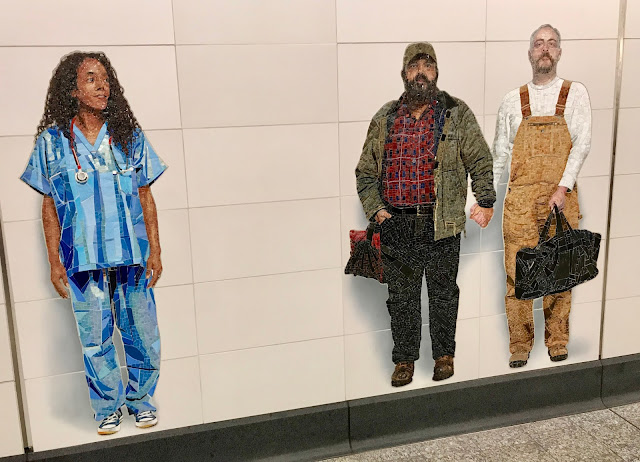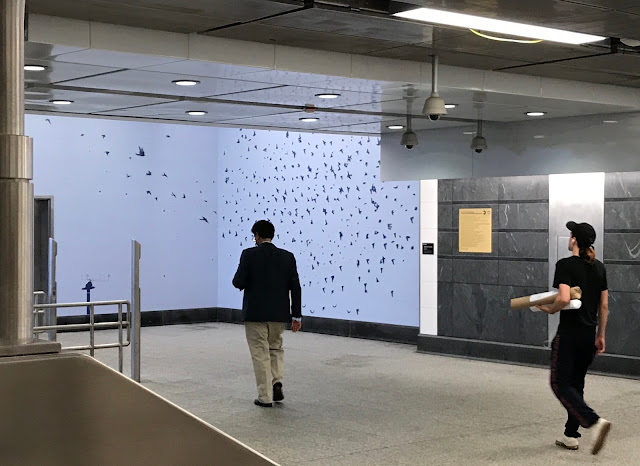I am of course referring to the Second Avenue subway, which now actually exists and runs in real life. Well, the first section of it does, anyway. But the fact that any of it is open and operating is really rather remarkable.
The Second Avenue subway was first proposed in 1919 but then not built due to the Great Depression, followed by World War II, and then other funding issues throughout the decades. There were elevated trains that ran along Second and Third Avenues that the subway line was meant to replace. Even though the underground line wasn't built in the 20th century, the elevated lines were destroyed to increase property values, Second Avenue in 1942 and Third Avenue in 1955.
This left just one line on the east side of Manhattan, which is insane. The line's 4, 5 and 6 trains carried 1.3 million people daily as of 2015, easily making it the most used subway line in the country.
The first phase of the new Second Avenue line cost $4.5 billion and opened on January 1, 2017, with the Q train running to new stations at 72nd, 86th and 96th Streets, and also connecting at the station at 63rd and Lexington Avenue.
Phase 2 would extend up to the line's northernmost section in East Harlem, with stations at 106th, 116th and 125th Streets. This phase has only received some initial funding for preparatory planning work but there are no definite dates for construction.
Phase 3 would extend the line all the way down to Houston Street on the Lower East Side, and Phase 4 would go down to its southern end at Hanover Square in the Wall Street area. Phases 3 and 4 don't have funding or any kind of timeline.
It took 98 years between the line being proposed in 1919 and Phase 1 opening in 2017. At that rate, Phase 2 would open in 2115, Phase 3 in 2213, and Phase 4 in 2311. I think the MTA should announce those dates as the planned openings so that any work completed before then would be a pleasant surprise.
The three new stations that opened this year all have the same design and basic layout, with escalators and elevators going down to the turnstiles, followed by a long walkway that runs the length of the station and has stairs leading down to the train platform.
You can see in the photos that "E Pluribus Unum" can be read on one side of a slab that runs over the platform area. The other side says "Excelsior," which is Latin for 'Good luck getting to your destination safely and on time.' Actually it means 'Ever Upward' and is the state motto.
The escalators that run from street level down to the entrances were really long, at least the ones I rode at 72nd and 86th Streets. They reminded me of the escalators in the Washington, D.C. Metro, though maybe they weren't quite that long.
The notable difference among the new stations is the artwork, with each having a different artist's work on display.
At 72nd Street, the artwork is by Vik Muniz and called Perfect Strangers. It is a series of glass mosaic life-size portraits scattered throughout the station that are very realistic and often amusing or quirky in some way. Muniz had people he knows pose as different characters for the portraits and they definitely liven up the station.
Muniz is a Brazilian artist who actually appears as a man fumbling amidst scattered papers (and a calculator). His son also posed as a guy dressed in a tiger suit and holding a plastic bag.
Here are some more of the mosaics followed by a close-up of the tile work.
There is also a mosaic portrait at street level with a balloon flying above. It is just at the entrance to the escalators.
At the opposite corner of the intersection is another entrance to the station, this one without escalators but only a long series of elevators. There was more art here, with a man at street level and birds flying above the elevators. All of these images seemed more photographic than mosaic, so I don't know if they were also by Vik Muniz or a different artist.
The art at the 86th Street station is by Chuck Close and is called Subway Portraits. There are 12 works, 10 in mosaics and 2 in ceramic tiles. The portraits are very detailed and life-like, with each having its own style and some even being out of focus to varying degrees. The subjects are artists, and I admit that I only recognized two of them: a self-portrait and one of Lou Reed, the legendary musician who died in 2013.
Here are some of the other portraits, including Kara Walker, Cecily Brown and Alex Katz.
At ground level near the escalators is a portrait of Cindy Sherman, very out of focus, and Philip Glass is overhead as people make the escalator descent.
Here is an entrance to the 86th Street station. It's nothing too fancy but it gets the job done.
The art at the 96th Street station does not have any portraits and is more abstract. It is by Sarah Sze and called "Blueprint for a Landscape." It consists of blue and white images that span across the station's different sections and levels, and almost seems like one big illustration that is a mishmash of all the different elements of the city thrown together and in motion.
Here is a look at some of the artwork:
At the other end of the station there were images of birds near the escalators:
And in the concourse there were blowing papers along both sides:
Recent numbers have shown the Second Avenue subway line to be a success thus far, with daily ridership at 176,000 in the first half of May 2017. That is up from 124,000 during its first month of operation in January. Starting this November, the MTA will add an extra Q train to run downtown during the morning rush hour and an extra Q going uptown during the busy evening commute.
More good news is that along with the Second Avenue line growing its numbers, it is easing the burden on 4, 5 and 6 trains at the four closest Lexington Avenue stations: daily ridership overall is down 26 percent and down 40 percent during the morning commuter rush.
That is a bit of welcome positive news for commuters dealing with a subway system that has been in crisis mode of late, not to mention all the problems with other train systems that run into the city. The next phases of the Second Avenue line may be on hold for a while with much of the city's infrastructure dangerously outdated and overwhelmed, but at least Phase 1 is open and making travel more bearable on the east side. And the artwork is pretty cool too.





























No comments:
Post a Comment